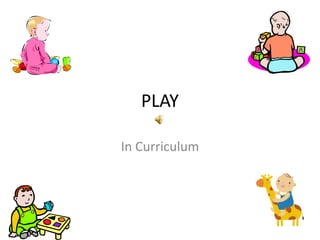
Play
- 2. Play as curriculum One of the main ingredients of any infant/toddler programs is play The benefits of play are enormous and go beyond the kinds of things we talk about so easily, like developing skills and learning concepts 1. Play offers children opportunities that come from nowhere else. 2. Through play, children get involved in open-ended exploration – they are not confined by rules, procedures, or outcomes. 3. Children at play have self-direction – that is they are making decisions about what they want to play and do. 4. The way we respond to infants/toddlers at play by giving them freedom, by helping them pursue their special interests, and by providing resources may result in children gaining lifelong models.
- 3. Adult Roles in Infant/Toddler Play 1. Encourage interactions and then stepping back 2. Practicing selective intervention 3. Providing time, space and materials 4. Give wants nothing quality time. Remaining available but not interrupting 5. Providing safety 6. Supporting problem solving 7. Providing scaffolding 8. Observing
- 4. How the environment influences play 1. Group size – larger groups tend to be over stimulating, and quieter children get ignored. Even when adult-child ratio is good, difficult for children to get truly absorbed in play. 2. Mixture of ages – some programs prefer that all the children are one age while others (Reggio Emilio) has children of all different ages in one room. If you do mix ages, be aware of protecting the youngest ones. In the case of mixing infants and toddlers, be aware of protecting the infants who are not moving and the toddlers who just learned to get around. a. Toddlers also need to be protected from equipment they are not yet ready to climb on or use. Also, if children are having a conflict and one is five and the other is two, you cannot stand back and let them resolve their own conflicts. The two-year won’t have developed the skills yet. 3. Setting up the space – most childcares have the environment set up so that it is clear what takes place in each area. Play space is usually separate from the rest area.
- 5. Setting up the Environment to Support Play 1. Keep play space separate from caregiving areas 2. Make sure everything in the play space is touchable 3. Provide for both fine and gross motor activity 4. Provide both soft and hard materials and play surfaces 5. Let children find unique ways to combine toys and materials 6. Put out the right amount of toys 7. Provide the right amount of choices
- 6. Play can be self-initiated. There can also be hands on play with an adult. Remember to still allow children to play on there own.
- 7. Caregivers should also enjoying playing while also providing a safe area indoors as well as outdoors. Children learn from exploring and playing.
